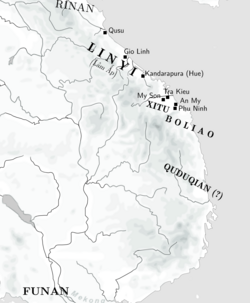Xitu / Xītú Guó | |||||||||||
|---|---|---|---|---|---|---|---|---|---|---|---|
| 5th century?–6th century? | |||||||||||
 Xitu in c. 450 AD | |||||||||||
| Capital | Unknown Trà Kiệu (disputed) | ||||||||||
| Common languages | Old Cam, Chamic, Sanskrit, Katuic | ||||||||||
| Religion | Perhaps Hinduism, Buddhism, Cham fork religion | ||||||||||
| Government | Monarchy | ||||||||||
| History | |||||||||||
• Established | 5th century? | ||||||||||
• Disestablished | 6th century? | ||||||||||
| |||||||||||
| Today part of | Vietnam | ||||||||||
Xitu (Vietnamese: Tây-đồ-quốc[1]; Chinese: 西屠國; pinyin: Xītú Guó; lit. 'Kingdom of Xitu'[2]) was the Chinese designation for a historical region or a Chamic polity or kingdom that was first mentioned in the mid of fifth century AD, is believed to be one of the predecessors of Champa Kingdom. It has been proposed to be located in the Thu Bồn River Valley, present-day Quảng Nam Province, Central Vietnam.[3]
- ^ "The origins of Champa: was there a kingdom of Xi-tu (西屠國) in the Thu Bồn valley?". jshe.ued.udn.vn.
- ^ Vickery 2011, p. 374.
- ^ Schweyer 2010, p. 107.